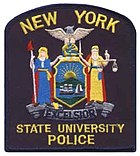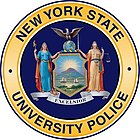
The State University of New York is a system of public colleges and universities in the State of New York. It is one of the largest comprehensive systems of universities, colleges, and community colleges in the United States. Led by chancellor John B. King, the SUNY system has 91,182 employees, including 32,496 faculty members, and some 7,660 degree and certificate programs overall and a $13.37 billion budget. Its flagship universities are Stony Brook University on Long Island and the University at Buffalo.

Stony Brook University (SBU), officially the State University of New York at Stony Brook, is a public research university in Stony Brook, New York. Along with the University at Buffalo, it is one of the State University of New York system's two flagship institutions. Its campus consists of 213 buildings on over 1,454 acres of land in Suffolk County and it is the largest public university in the state of New York.

The State University of New York at Albany, commonly referred to as the University at Albany, UAlbany or SUNY Albany, is a public research university with campuses in Albany, Rensselaer, and Guilderland, New York. Founded in 1844, it is one of four "university centers" of the State University of New York (SUNY) system.
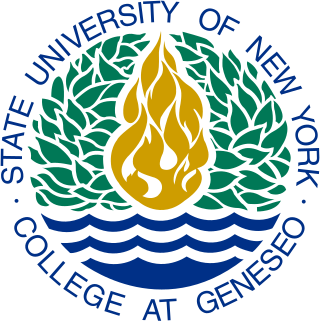
The State University of New York College at Geneseo is a public liberal arts college in Geneseo, New York. It is part of the State University of New York (SUNY) system. The college was founded in 1867 as the Wadsworth Normal and Training School before it became part of the new State University of New York system as a state liberal arts college in 1948.
Campus police or university police in the United States and Canada are sworn police or peace officers employed by a college or university to protect the private or public property of the campus and surrounding areas and the people who live, work, and visit it. In instances where they are not technically police officers, they are often known as campus safety or campus security.

A police academy, also known as a law enforcement training center, police college, or police university, is a training school for police cadets, designed to prepare them for the law enforcement agency they will be joining upon graduation, or to otherwise certify an individual as a law enforcement officer, typically a police officer.

The Jeanne Clery Disclosure of Campus Security Policy and Campus Crime Statistics Act or Clery Act, signed in 1990, is a federal statute codified at 20 U.S.C. § 1092(f), with implementing regulations in the U.S. Code of Federal Regulations at 34 CFR 668.46.
In the U.S. state of Oregon, enforcement of local, state, and federal law on public university property is delegated to a number of security, public safety, and police agencies.
The University of the State of New York (USNY), its policy-setting Board of Regents, and its administrative arm, the New York State Education Department, oversee all public primary, middle-level, and secondary education in the state. The New York City Department of Education, which manages the public school system in New York City, is the largest school district in the United States, with more students than the combined population of eight U.S. states. Over 1 million students are taught in more than 1,200 separate schools.
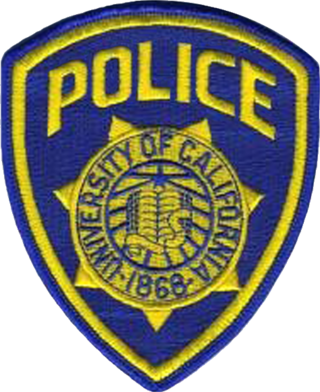
Police departments in the University of California system are charged with providing law enforcement to each of the system's campuses.
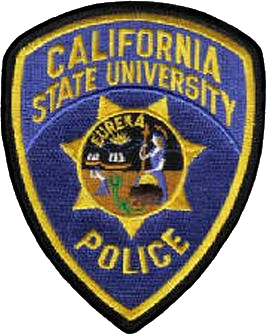
The California State University police departments(CSUPD) (known within the California State University system as the Cal State Police or University Police) are the police departments of the California State University system. Their police officers are duly sworn peace officers of the State of California, as established by section 830.2(c) of the California Penal Code. There are a total of 23 campuses in the California State University system, each with their own police department. Each csu' police department has its own chain of command, however some of the policies are system-wide.

The Virginia Tech Police Department (VTPD) is a nationally accredited police department with jurisdiction over Virginia Polytechnic Institute and State University. The departments original accreditation with CALEA was awarded on November 18, 1995 and the department has continued with re-accreditation. In November 2015, the department met "gold standard" and also won CALEA's "Accreditation with Excellence" award.

The New York State Office of Mental Health Police is responsible for providing onsite security and fire safety/prevention services at the 23 state run psychiatric centers located in New York State.

The Rutgers University Police Department (RUPD) is a campus police agency responsible for law enforcement on the New Brunswick, Newark, and Camden campuses of Rutgers University. RUPD is a department of the university's Division of Administration and Public Safety, overseen by Rutgers Institutional Planning and Operations (IP&O) which also houses Rutgers University Emergency Services (RUES) which is responsible for Emergency Medical Services and emergency management on the campus as well as responding to fire and hazardous materials emergencies in coordination with local first responders. The Division of Administration and Public Safety also oversees the campus bus system, the Rutgers Golf Course, and other services on campus.
The Massachusetts Institute of Technology Police Department is the police agency charged with providing law enforcement to the campus of the Massachusetts Institute of Technology. The 168-acre campus extends over 1 mile (1.6 km) along the northern bank of the Charles River basin.

The University of Missouri Police Department (MUPD) is the primary law enforcement agency for the University of Missouri (Mizzou), a public research university located in Columbia, Missouri and the flagship campus of the University of Missouri System.

The murder of Jeanne Clery occurred in 1986 in Bethlehem, Pennsylvania at Lehigh University. Clery, who was a freshman at the time of her death, was raped and killed in her campus dormitory. Clery's parents, who believed the university had failed to share vital information with its students regarding campus safety, campaigned for legislative reform for several years following their daughter's death.
Inspector Vicki King is a pioneering threat safety scientist in the healthcare sector. She is the leader of the Threat Assessment Unit at the University of Texas at Houston Police Department, which is a component of the University of Texas System.
